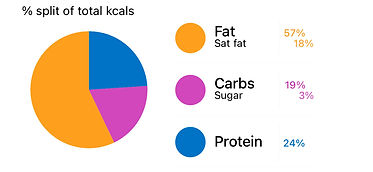.jpg)
corzetti in Sicilian pesto with roast chorizo and pork shoulder
The two pesto sample recipes you can read here aren't pesto dishes in the more traditional sense where the pesto alone is the star of the show. Instead, in both cases the pesto is treated like a kind of a base sauce for other ingredients; using pesto this way is becoming more and more popular (at least in South East London!) and in fact it's exactly the treatment that the original Pesto Genovese gets - there a 'base' basil pesto gets the addition of boiled green beans and boiled potatoes.
This pork shoulder recipe with the unusual corzetti shape uses Sicilian or 'red' pesto as a base, and adds chorizo and hot smoked paprika for more layers of heat and smokiness!
WHAT YOU'LL NEED TO DO
(scroll down for the full method)
-
prepare the individual ingredients for the pesto
-
roast the chorizo
-
grate the cheese, chop the garlic, sun-dried tomatoes
-
blend the pesto
-
make sure the pesto is at room temperature
-
if you want to serve with pangrattato, make some of that!
-
cook the pork shoulder, cut it into pieces, re-fry
-
boil the pasta
-
combine the pesto and pasta, adding pork
.jpg)
corzetti in Sicilian pesto with roast chorizo and pork shoulder
INGREDIENTS
-
3 pork shoulder steaks
-
250g chorizo
-
freshly grated nutmeg to taste
-
hot smoked paprika to taste
PESTO SICILIANO
-
25g pinoli
-
25g flaked almonds
-
160g sun-dried tomatoes
-
65g parmesan/pecorino mix
-
1 medium garlic clove (4g)
-
20 basil leaves
PASTA
-
500g dry corzetti
MANTECATURA
-
none
METHOD
There are two popular ways of making a ‘red’ (ie. tomato) pesto, also known as Pesto Siciliano. Either use fresh plum or cherry tomatoes and roast them before incorporating into a pesto mix, or use sun-dried tomatoes, in oil in a jar or dried and rehydrated. Using fresh tomatoes can sometimes give a more watery result, unless of course you really reduce your sauce before combining it with the pasta.
By far the quickest method is to use sun-dried tomatoes in a jar. Don’t be ashamed. I actually think these give the most intense, tomato flavour you can get - so save time and go for ‘maximum flavour with minimum effort,’ as a wise man once said.
If you’d prefer to make sun-dried tomato pesto from scratch, use the ingredients listed above as a guide and then start blending / pestling small quantities of all the ingredients, adding one at a time and always tasting regularly as you go, until you get to the balance of flavours and the quantity of pesto that you want.
In Southern Italy, ‘red’ pesto is often served with a topping of pangrattato (fried breadcrumbs), rather than pecorino or another cheese. If you’d like to included pangrattato in this dish, follow the recipe for Pangrattato in the Technique section. And yes, you can always add cheese too to pasta topped with pangrattato.

Once you've made the pesto, roast the chorizo whole for 35-ish minutes and then chop it into uneven, ‘rustic’ chunks. I dry-fried the pork shoulder in a heavy iron pan with some bay leaves, before removing from the heat, cutting into small pieces and setting aside.
As the pasta went into the boiling water I returned the pork strips and chorizo to the heavy iron pan and seared it on a very high heat. Colouring and crispiness. Freshly ground black pepper. A squeeze of lemon juice.
When you're happy that the pasta is cooked, put about half the total pesto into a pre-warmed pasta wok, and loosen it up with perhaps a third of a ladle of cooking water. Fish the pasta out of the cooking water and add it immediately to the pasta wok, off the heat. Toss to combine, adding more pesto and tiny amounts of cooking water if it feels too sticky, but don't turn it into a runny mess. When the pasta and sauce are nicely combined, throw in the pork and chorizo. Toss and combine.
Serve sprinkled with hot smoked paprika and pecorino.
NUTRITION PER SERVING
KCAL: 932
Fat: 58.1g
S/Fat: 18.6g
Carb: 45.4g
Sug: 6g
Fib: 6.1g
Prot: 54.5g
Salt: 4.46g

